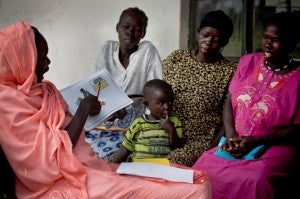
In South Sudan, decades of civil war have wreaked havoc on basic infrastructure, including health facilities and roads. Given the lack of transportation infrastructure, it is not surprising that only about 12% of women give birth in facilities, resulting in the world’s highest maternal mortality ratio and neonatal mortality rate at 2,054 per 100,000 and 52 per 1,000 live births, respectively.
In response, the South Sudanese Ministry of Health (MOH) has embraced new and innovative ways of working, including task-shifting of high-impact interventions to improve access to high-quality health care. This is especially evident with the MOH’s partnership with USAID’s flagship Maternal and Child Health Integrated Program (MCHIP). The MOH is collaborating with MCHIP’s Integrated Service Delivery Project (ISDP) to pilot an innovative program[1] to combat the biggest killer of women giving birth, postpartum hemorrhage (PPH).
This introductory PPH prevention program, carried out in Mundri East and Mvolo counties of Western Equatoria State from September 2012 to March 2013, focused on:
- Clean and safe delivery, which includes the active management of the third stage of labor (AMTSL);
- Essential newborn care, which includes newborn resuscitation; and
- Advance distribution of misoprostol for self-administration at home delivery.
By supporting the integration of essential newborn care into PPH related trainings, the MOH and MCHIP are adopting approaches that link maternal and newborn interventions to reduce newborn complications.
The day of birth is the most dangerous for mothers and their babies, resulting in more than 40% of maternal and newborn deaths and stillbirths. To illustrate this point, Sheena Currie, MCHIP’s Senior Maternal Health Advisor said, “Like many maternal deaths, many newborn deaths are preventable through skilled care around the time of birth, such as breastfeeding support, cord and thermal care. Caring for the mother-baby dyad is just common sense, as they are so interdependent.”
In fact, MCHIP has made it standard practice to integrate essential newborn care into clean and safe birth programs. In Yemen, for example, MCHIP supported the introduction of new AMTSL guidelines, which also included information on delayed cord clamping, skin-to-skin contact, and immediate breastfeeding, all interventions that improve newborn health.
Sadly, the scale of suffering endured by the South Sudanese dramatically increased when conflict erupted last December. Yet community midwives and volunteer home health promoters (HHPs) trained and supported by ISDP have carried on their work by visiting pregnant women in their home, helping them prepare a birth plan and educating them in self-administering misoprostol and keeping the baby dry, clean and warm. More than 100 pregnant women gave birth between December 2013 and January 2014; they all survived, thanks in large part to ISDP-supported health providers.
Since the conclusion of the PPH prevention program pilot phase, other donors and programs have started to replicate this intervention in other South Sudanese states. The training materials for clean and safe delivery for both skilled birth attendants and HHPs are currently under MOH review; when approved, they will be used nationally by other implementing partners. This bodes well for the program’s long-term sustainability that links newborn and maternal health interventions.
If South Sudan’s security situation stabilizes, the government and partners may begin planning a national roll-out of this novel PPH prevention program. Current recommendations are to further integrate newborn and maternal high-impact interventions by including chlorhexidine for newborn umbilical cord care in clean and safe delivery trainings. If included, this intervention could reduce the number of newborn infants dying from infection.
Much can be learned from these efforts. If scaled up in South Sudan or replicated in other developing countries, this and similar programs have the potential to prevent many maternal and neonatal deaths. Perhaps equally important, this program has used a comprehensive approach targeting both facility and homebirths, thereby increasing access to lifesaving services. This is particularly true in isolated, hard-to-reach areas, where high-quality health care is limited and women are more likely to give birth at home without skilled attendants.
[1] Save the Children and Mundri Relief and Development Association (MRDA) were the program’s in-country partners for implementation. VSI supplied the misoprostol and Systems for Improved Access to Pharmaceuticals and Services Program (SIAPS, implemented by Management Sciences Health) distributed it for the two counties. MCHIP technical guidance and assistance was provided by Jhpiego and JSI.